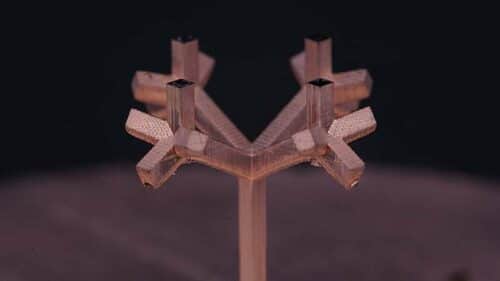A 3D printing method creates antennas by combining metals and polymers, enabling designs and applications, including use in extreme environments.

Most personal electronic devices rely on antennas to send and receive data, and there is increasing demand for lightweight antennas in applications like 5G/6G networks, wearable devices, and aerospace technologies such as CubeSats. To address the limitations of traditional manufacturing methods, which restrict structural complexity and material combinations, researchers at UC Berkeley have developed a 3D printing platform that enables more flexible antenna design and rapid production of complex structures.
The platform, called “charge programmed multi-material 3D printing” (CPD), enables the fast production of 3D antenna systems. It combines highly conductive metals with various dielectric materials in intricate 3D layouts.
The CPD method uses a desktop digital light 3D printer and catalyst-based technology to pattern different polymers in specific areas for metal plating. Its selective plating technology allows the polymers to absorb metal ions only in targeted locations based on the intended antenna design.
The CPD method can integrate with many multi-material 3D printing techniques. It enables the creation of complex 3D structures, including intricate lattices, and has demonstrated the deposition of copper with high conductivity, as well as magnetic materials, semiconductors, nanomaterials, and their combinations.
The team initially considered antennas as a primary application. After consulting with experts in the field, they recognized the potential of this technology to transform antenna printing and enable entirely new design possibilities.
Printing conductive and dielectric materials together is especially valuable for antennas in extreme environments. For instance, due to the harsh conditions, regular polymers cannot function in space. High-temperature polymers like Kapton, which are stable in extreme heat and cold, can now be integrated with metal patterns in 3D, making them ideal for aerospace applications.
The researchers aim to explore the full potential of their 3D-printed antenna technology by pushing the boundaries of antenna design complexity. Greater control over this complexity allows precise shaping of electromagnetic waves, similar to how a painter uses a brush to control paint application. To advance practical applications of the technology, the team has launched a startup focused on developing flexible medical sensors that can adapt to various shapes, such as the contours of a hand.
Reference: Zhen Wang et al, Ultra-light antennas via charge programmed deposition additive manufacturing, Nature Communications (2025). DOI: 10.1038/s41467-024-53513-w





